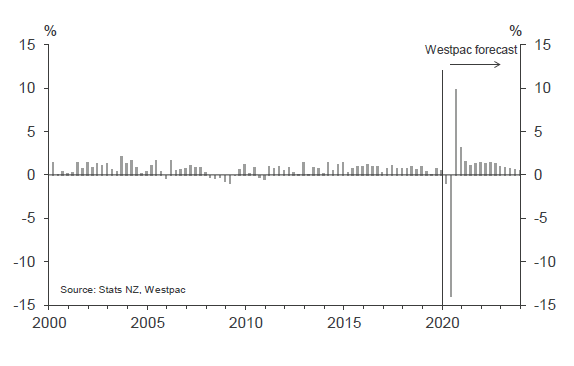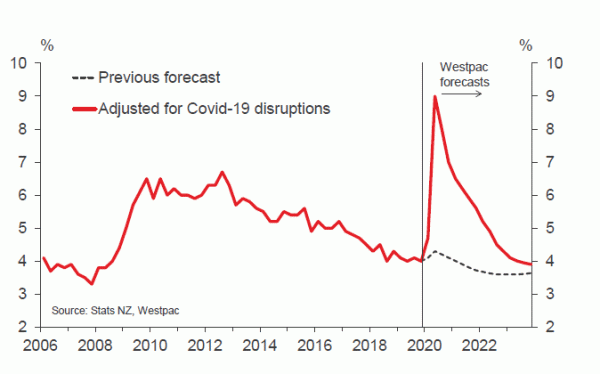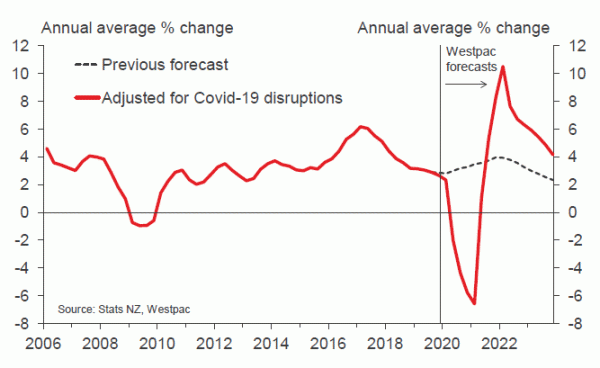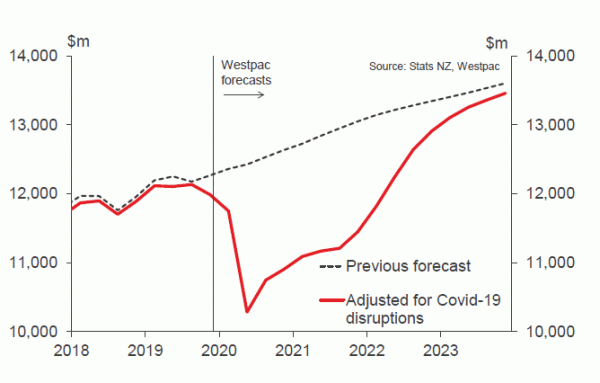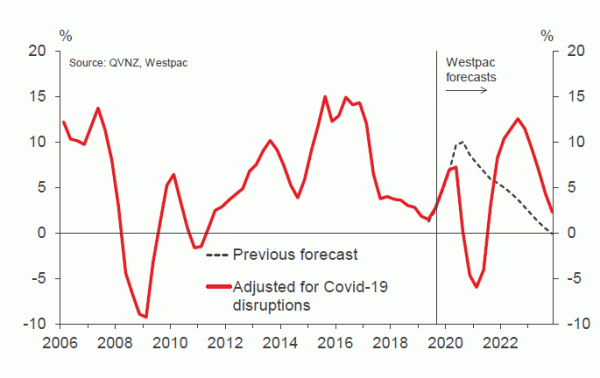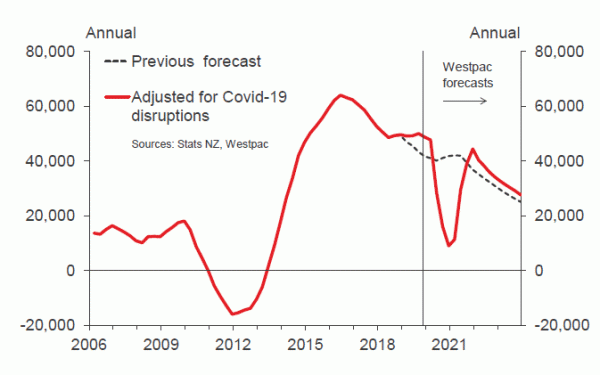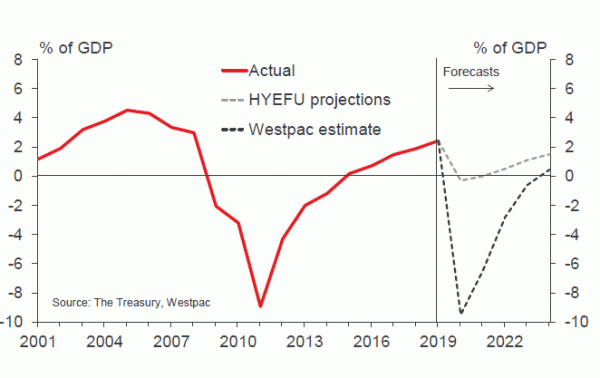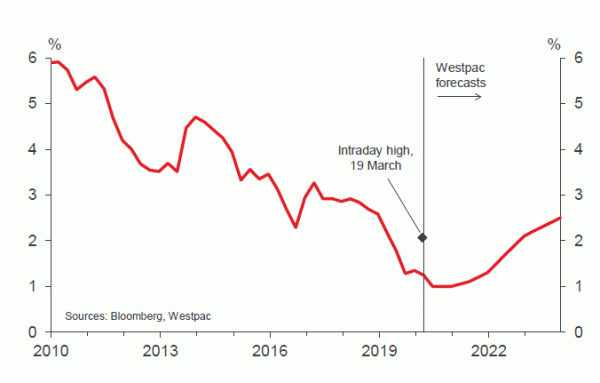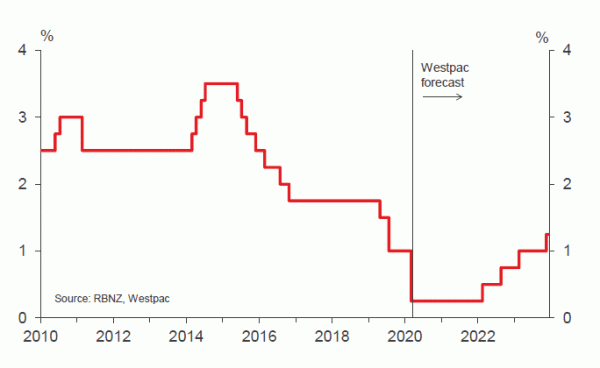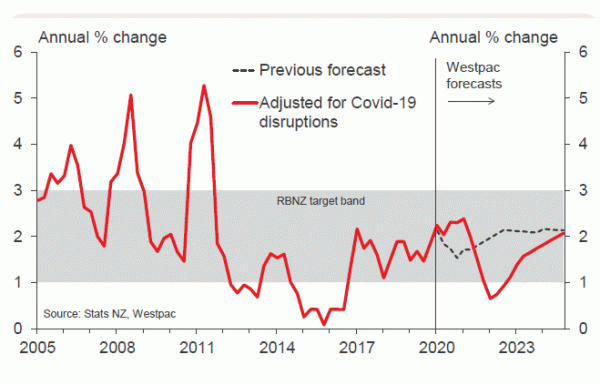- We have estimated the macroeconomic impact of each Covid-19 Alert Level.
- We forecast that GDP will drop 15% over the March and June quarters, but will rise 10% in September.
- We expect that the unemployment rate will reach 9% and house prices will fall 7%.
- The recovery will be much sharper than previous recessions, but will still take years.
- The Government’s response has been sensible, and will cushion the blow, but it is expensive.
- We forecast that the Government debt to GDP ratio will rise from 18.5% now to 40% by 2022.
- The Reserve Bank has done a lot to calm markets and ensure low interest rates.
- We estimate that the Government will have to borrow $48bn between now and June 2021. The RBNZ has committed to buying $30bn of that, but will have to do more.
- The RBNZ can continue its massive stimulus programs so long as inflation remains low, which is expected but not guaranteed.
The Covid-19 lockdown was the right decision to save lives, but the economic cost will be severe. This bulletin sets out our “best endeavours” forecast.
A total lockdown to combat Covid-19 was the right decision for the Government to make, because saving lives comes first. However, the impact on the economy is going to be severe. Attempting to produce forecasts during the moving feast that is Covid-19 is a fraught exercise, but in this bulletin we will set out our best endeavours. A full set of forecasts is presented in the table at the end of the bulletin.
Economic impact of each Alert Level
The Government’s four-level alert scheme gives us a useful structure. For each Alert Level, we have estimated the likely impact on activity in 103 industries across the entire economy, yielding a rough estimate of the total economic impact.
At Alert Level 2 economic activity would be reduced by almost 4% relative to normal. The biggest economic impact would be that the borders are virtually closed to international travellers and domestic travel is limited.
At Alert Level 3 the decline in GDP would be 8%. All mass gatherings are banned and public venues like cafes, restaurants, cinemas and libraries are closed. Some nonessential businesses would close but others would continue to operate.
At Alert Level 4, which we are in now, economic activity declines by about 33%. All but the most essential businesses are required to close and most people are required to stay at home.
The impact of Covid-19 on GDP will depend on which Alert Level the country is in, and for how long. At this stage we are assuming Alert Level 4 for four weeks. Beyond that, we are assuming Alert Level 3 until the end of June, and Level 2 until the end of September. However, we assume that individual regions will revert to Level 4 at times. As we get more information about which Alert Level the country is likely to be at, we will be able to update our forecasts.
Even at lower Alert Levels, the possibility of a return to Level 4 will keep businesses and consumers cautious until Covid-19 has completely passed. And no matter what New Zealand’s situation, other countries will be battling Covid-19 throughout, which will impact exports. Both of these considerations are factored into our forecasts.
Based on all of the above, we have concluded that New Zealand GDP will fall by 1% in the March quarter and 14% in the June quarter. The end of the lockdown will allow a large jump in economic activity as businesses reopen and as some catchup activity occurs (for example, haircuts and doctors’ visits will have been delayed). We are forecasting a 10% lift in GDP for the September quarter, although that would still leave the economy 5% smaller than at the start of the year. For comparison, during the entire GFC the economy shrank by 2.7%.
We estimate that annual average GDP – which measures economic activity over a whole year compared to GDP over the whole of the previous year – will be down 5.6% in 2020.
Quarterly GDP growth
Covid-19 impact on the New Zealand economy – annual average GDP growth
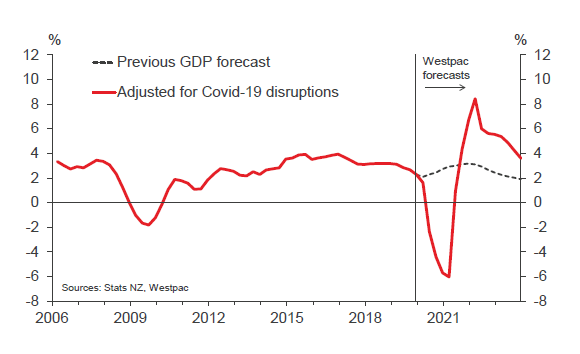
COVID-19 impact on the New Zealand economy – level of GDP 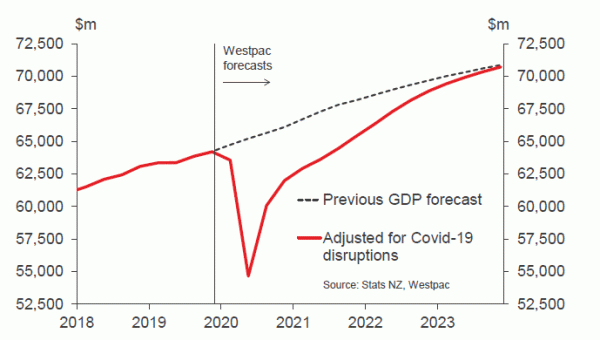
Unemployment
The impact on employment will be more moderate than the reduction in GDP. Most firms will hold onto their workers through the lockdown, although in industries where working arrangements are often more casual, such as hospitality, there could be more layoff s. However, the Government’s enormous wage subsidy scheme will limit the job losses. Overall, we estimate that around 207,000 jobs will be lost, equating to 7% of the workforce. We expect that this would push the measured unemployment rate up to 9%, with some of the hit coming through a drop in labour force participation. It’s likely that many affected workers will not classify themselves as ‘actively seeking work’ at a time when few businesses are hiring, especially during the lockdown period.
Hardest hit industry sectors
The hardest hit industries will be those involved in tourism and hospitality related activities, including tour operators, car rental firms, restaurants, cafés and bars. We are assuming an almost complete absence of foreign tourism until late this year, and only a gradual recovery beyond that. The building and construction sector will go into stasis for a while, affecting numerous small sub-contractors and supplier industries such as secondary metal machining, cutting and fabrication. The forestry sector will be hit by a double whammy of an earlier slowdown in demand from Covid-19 hit China and now an enforced local lockdown. And non-grocery retailers, including motor vehicle retailing, are closed during the Level 4 lockdown and will face reluctant consumers after the lockdown is lifted. In China, online sales and health food retailing boomed during their lockdown period, and the same could happen in New Zealand.
Layoff s and business failures are more likely to occur in industries that feature a high proportion of small firms, such as wholesale and retail, hospitality, rental and leasing, tourism and small manufacturers. Smaller firms are more likely to lack the deep pockets required to tide themselves over during the period of disruption.
Once the crisis has passed, however, it will be small business that leads the recovery. Cheap money and low barriers to entry will encourage new entrepreneurially driven firms to spring up. Large firms are more likely to survive the downturn but will be less dynamic because they will focus on reducing debt
Shape of the recovery
The rebound in GDP growth will much sharper than we typically see following recessions, but a full recovery in economic activity will still take years. This will mean a more rapid decline in unemployment and rise in GDP than, for example, after the GFC. However, a full recovery in the economy will take years.
Consumer spending will partially bounce back as soon as gatherings and travel are allowed, leading to quite rapid rates of growth for a while. However, a full recovery in consumer spending will take longer. Some people will have lost their jobs, and others will become more financially cautious. Both groups will curtail their spending. Even people untouched by the labour market downturn will find that their balance sheets have been damaged. KiwiSaver balances have already fallen, and house prices are likely to fall. This will lower households’ wealth, requiring them to reduce consumption and save more in order to rebuild their balance sheets.
Household consumption spending
The recovery in the business sector will be slower than for consumers. Many firms will fold during the disrupted period and it will take time for new entrepreneurs to take their place. Other firms will have borrowed to get through the lockdown, and will enter the post-Covid-19 era with high debt levels. This will make it harder to raise capital and expand. These firms will focus on balance sheet repair for some time, leading to only a gradual recovery in unemployment and business investment.
Business investment spending – level
Around the world, other countries will be dealing with much the same challenges, meaning a slow recovery in New Zealand exports.
The big positives for the recovery phase will be low oil prices, ultra-low interest rates, and plans for massive Government infrastructure spending. Monetary and fiscal stimulus of this type were the prescriptions for the countries most heavily affected by the GFC, and they worked. Danger really sets in when monetary and fiscal stimulus is unavailable. For example, following the GFC Greece lacked control over interest rates and had a weak Government balance sheet. Fortunately, New Zealand is in neither predicament, so we will be able to stimulate the economy once Covid-19 has passed.
Housing market
New Zealand’s housing market is currently frozen amid the lockdown, but when house sales resume prices are likely to decline. There is little reason to suppose that the long-run fundamental value of property has changed, but short-term market realities certainly have. Job losses and business failures will put fewer people in a position to buy property, and other erstwhile buyers will be too nervous to act. The plan to grant repayment holidays to mortgage borrowers affected by Covid-19 will limit forced selling, but there will still be some people whose circumstances require them to sell later this year. How far prices fall depends mainly on sentiment, which is hard to predict. For now we are pencilling in a 7% decline over the second half of 2020, based on the house price declines seen in past New Zealand recessions. Beyond 2020 we expect ultra-low interest rates and a recovering economy to slowly return house prices to their pre-Covid-19 trajectory, so we are forecasting house price inflation of 8% in 2021 and 12% in 2022.
Population growth
The restrictions on international travel mean that migration into New Zealand will fall to very low levels over the coming months. Departures are also likely to fall, but the overall result will still be a sharp decline in the rate of net migration. When the border restrictions eventually ease we’re likely to see lower levels of international arrivals for some time as lingering softness in the New Zealand labour market means that we will look less attractive to potential migrants. Population growth will drop from around 1.5% in recent years to just 0.7%, impacting growth in retail sales and demand for houses. Some employers may also find it difficult to source staff with specialised skills. However, we do expect New Zealand’s net migration rate to recover once Covid-19 has passed.
Net migration
The government response – and the impact on debt
The Government’s job is to backstop the economy through the Covid-19 disruption so that the recovery can be as smooth as possible, while keeping its own balance sheet reasonably intact. We have been impressed with the Government’s response to date, which we think will do a lot to minimise long-term damage to the economy. Most of the Government’s actions have met our three criteria for good Covid-19 policies: they should be timely, targeted and temporary. Most importantly, the Government should avoid taking on too much new recurring expenditure, so that it can demonstrate to markets that it has the means the to repay the huge debt it is going to incur.
The central plank of the response so far is wage subsidies for workers in affected industries. This will be a massive aid in keeping firms solvent, people attached to their jobs, and unemployment manageable. The downside is that this policy is incredibly expensive, so the Government can’t keep it up for long.
The Government will automatically drift into deficit as tax revenue drops and expenditure on the likes of health and social welfare increases. We have calculated that this automatic deficit, combined with the rescue measures already announced, will require the Government to increase its borrowings by $65bn over the coming four years. For our forecasts we are assuming further economic rescue measures will be announced, taking the increase in debt to $70bn. The government debt to GDP ratio is currently 18.5%, but we expect it will rise to 40% by mid-2022. That is high by New Zealand standards, but low by international standards and quite manageable at today’s low interest rates. If the situation is well managed the debt to GDP ratio should come back down as GDP increases and Government deficits gradually shrink.
The Government is working on a loan guarantee scheme for small and medium sized businesses. Government will take 80% of the risk while the banks take 20%. Furthermore, the Government is working with banks to provide repayment holidays for mortgage holders. The success of these schemes will depend on the details, which we are yet to see, but the headlines looked sensible to us. Only the Government has a big enough balance sheet to backstop the business sector, but bringing the banks alongside to some extent will leverage the banks’ credit expertise. The really positive thing about these schemes is that they won’t stress the Government’s balance sheet as much as the wage subsidies. Under these schemes the Government will effectively be providing bridging finance, most of which will eventually be paid back.
Operating balance as a % of GDP
Net core crown debt as a % of GDP 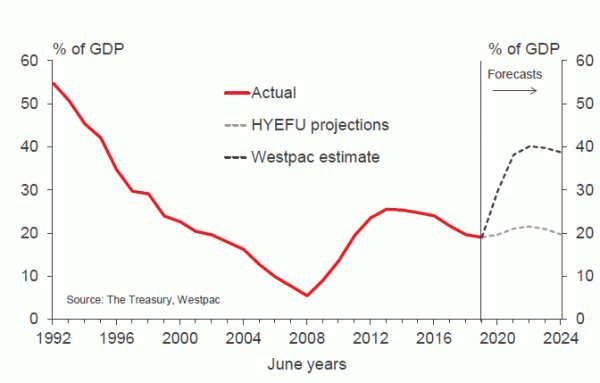
Financial markets, interest rates and the exchange rate
Asset prices around the world have plunged to “fire sale” levels. Panicking Mum and Dad investors are switching their portfolios to cash en mass. Fund managers are therefore required to sell assets such as equities at whatever price they can get. With few buyers on the other side, the result has been heavy price declines. We seriously doubt that the long-run fundamental value of companies has fallen anywhere near as far as the declines in equity market indexes imply.
The turmoil on global financial markets has had a real impact on New Zealand, including a sudden lift in the interest rates on New Zealand Government bonds and on interbank lending. This occurred a couple of weeks ago, and left unchecked could have caused an unwanted increase in the interest rates that ordinary businesses and households pay or receive. The Reserve Bank has done a good job of calming the situation down. Its massive OCR cut was the first step toward lowering interest rates. Its Term Auction Facility could provide virtually unlimited funding to banks if required. Its market liquidity measures have smoothed the functioning of some (but not all) financial markets. And most importantly, its Quantitative Easing program has provided a buyer for Government bonds, which will soon be in abundant supply due to the Government’s sudden need to borrow. The rates at which banks lend to one another have fallen to roughly their normal spread over the OCR, and Government bond rates have come down substantially. In our view the Reserve Bank has done enough, for now, to keep New Zealand interest rates low and markets functioning.
We expect that the Reserve Bank will calibrate its bond buying program such that the 10-year Government bond rate stays near 1% for the remainder of this year. We expect a gradual lift in 10-year bond rates next year. We are not certain what quantity of bonds the Reserve Bank would have to buy to achieve this, but we suspect it may end up being more than the $30bn that the RBNZ has already committed to. We forecast that outstanding Government debt will increase by $48bn between now and June 2022. The RBNZ will probably have to soak up more than $30bn of that to keep bond rates low.
Interest rate on 10-year government bond rate
New Zealand’s exchange rate usually declines in times of global economic stress, and this time has been no exception. At times like this investors tend to flee to safe haven currencies like the US dollar and the Japanese Yen, and away from more peripheral currencies like the Kiwi.
We expect the New Zealand dollar to remain low for as long as markets are extremely nervous about Covid-19. But as the emergency starts to ease, potentially over the second half of this year, we would expect the NZD to recover. New Zealand’s economic fundamentals will be weakened and interest rates will have fallen, but by no more than many other countries’. And our position as an exporter of high-quality food will likely see our terms of trade remain high, supporting the exchange rate.
We expect the OCR will remain at 0.25% until 2022.
Official cash rate forecast
Inflation
Inflation may seem like an irrelevance right now, but actually it is one of the biggest uncertainties, and will be one of the biggest factors in determining how successfully New Zealand recovers from Covid-19. The stimulus package basically consists of the Government financing its spending by issuing bonds, which are bought by the Reserve Bank. This was traditionally known as money printing, but today is called quantitative easing (QE). QE tends to boost inflation. It has been deployed since the GFC in countries where inflation threatened to turn negative, and has more-or-less been successful at preventing deflation.
The limit on how far the Reserve Bank of New Zealand can go with QE is its inflation target. We expect that inflation will drop over the coming couple of years in response to the weak economy. This will allow the Reserve Bank to continue with QE and the stimulus package will work smoothly until it is no longer needed.
But it is conceivable that upward pressure on inflation could emerge, for example if permanent disruptions to global supply chains caused higher production costs, or if global productivity growth is harmed. This could eventually force the Reserve Bank to curtail its QE program and allow interest rates to rise. In turn, that would hamper the recovery and would make it more difficult for the Government to continue borrowing. We view this as a risk scenario only, but it does illustrate why inflation will be important to watch.
Consumer price inflation




